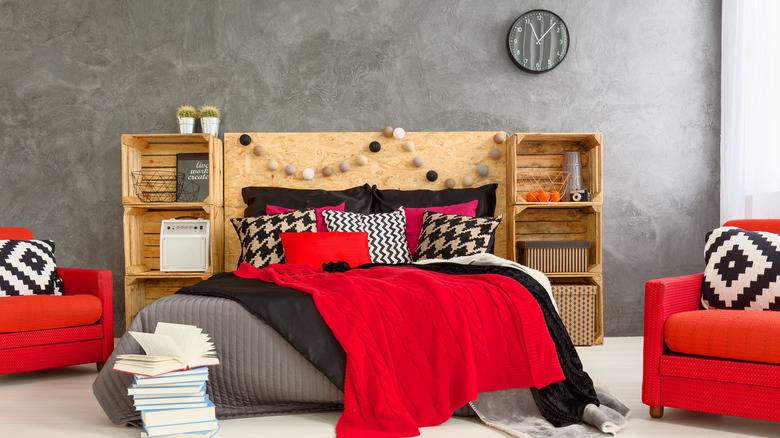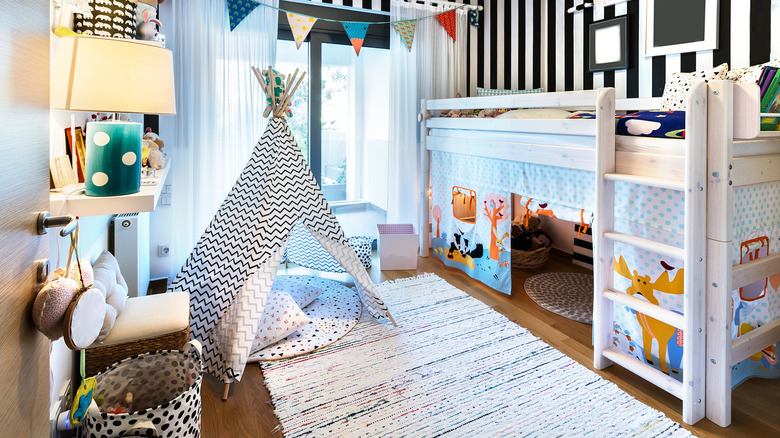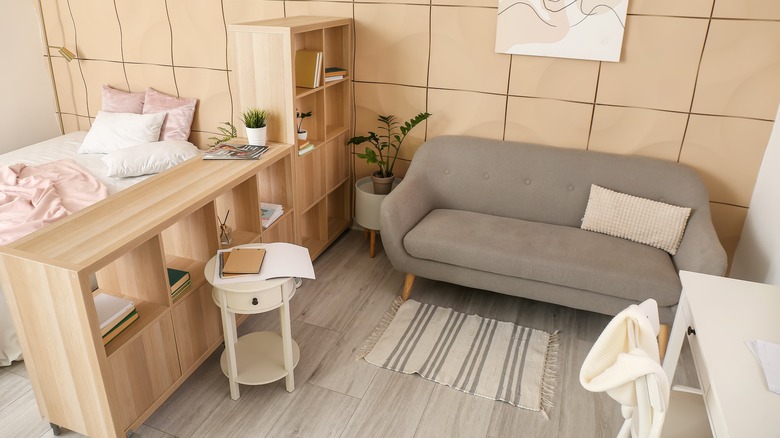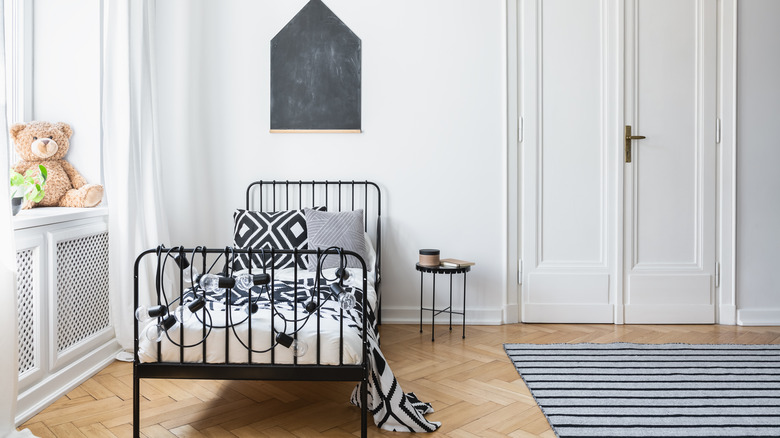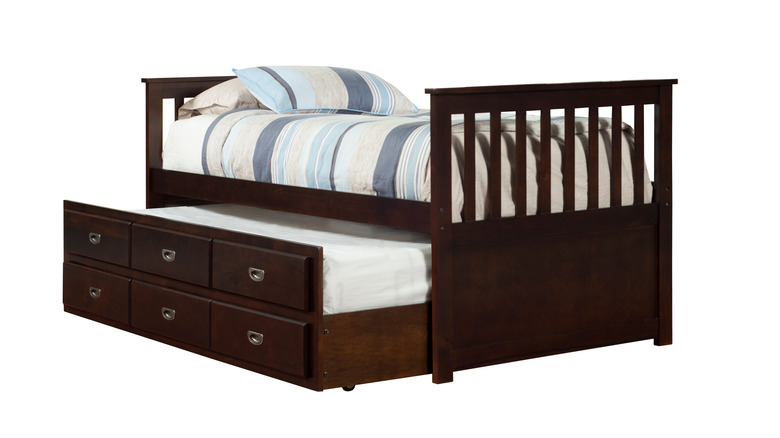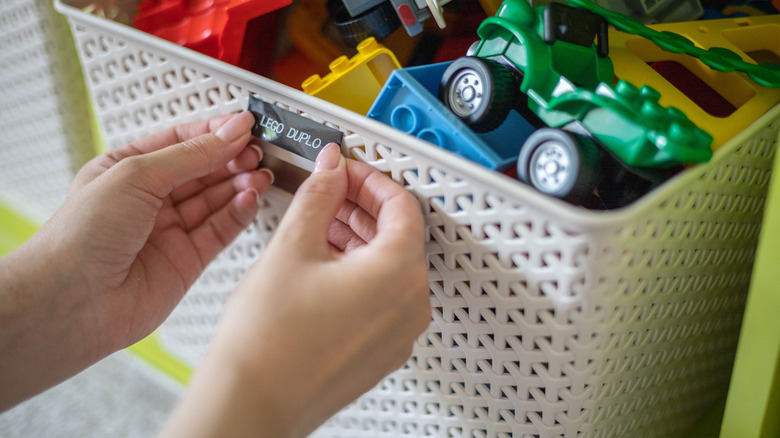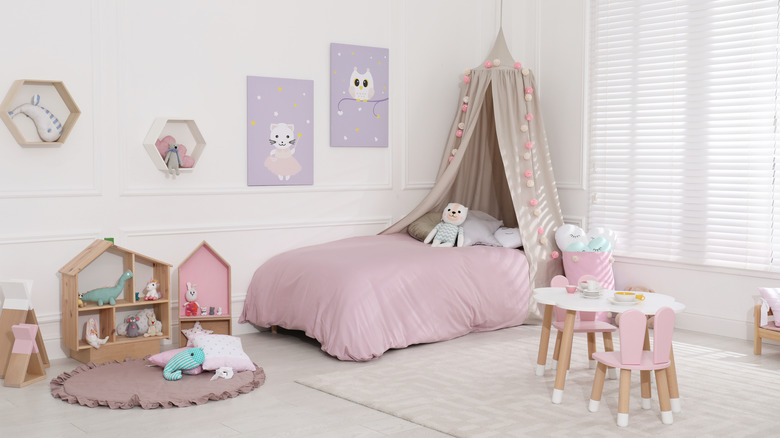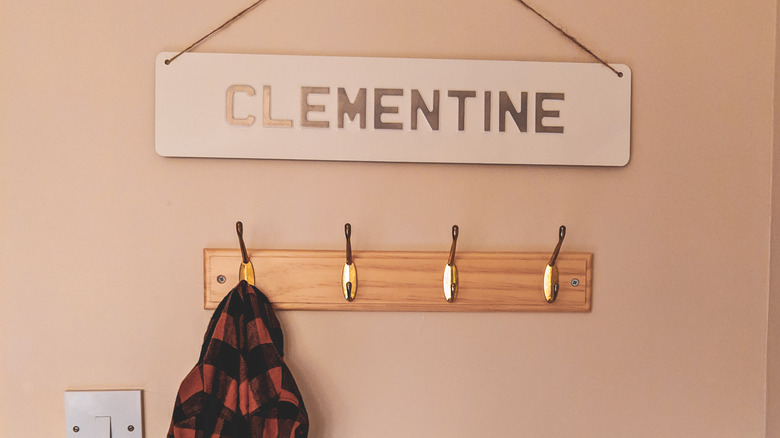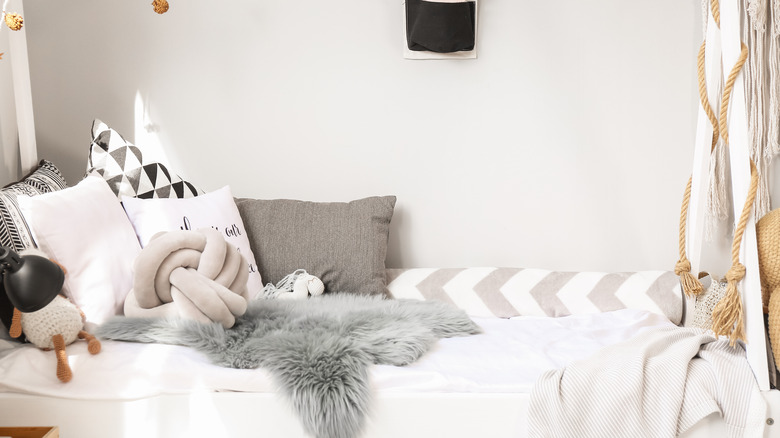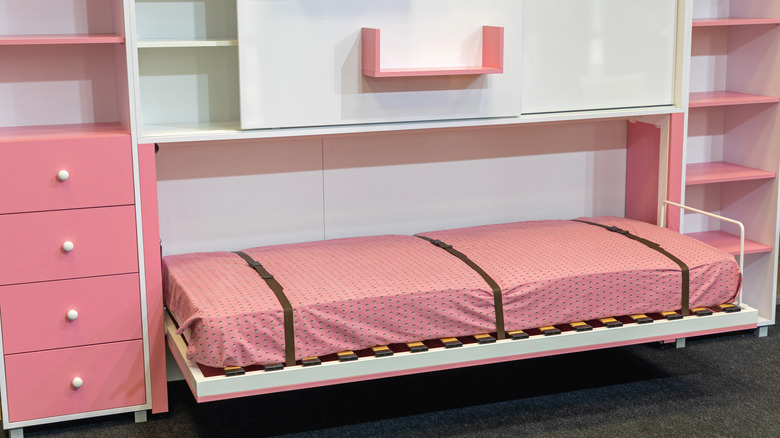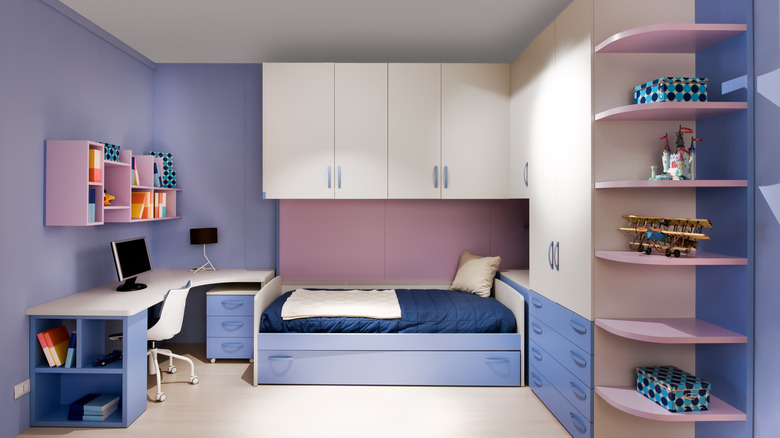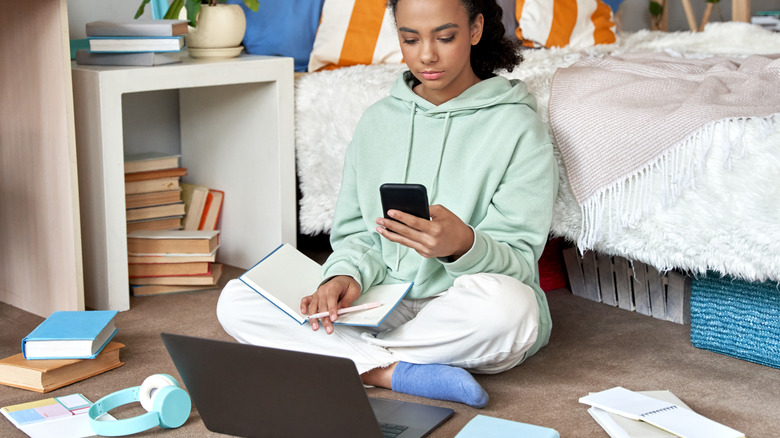How To Create A Comfortable Shared Bedroom For Kids
Some parents have their children share a bedroom even if it isn't necessary because they remember the fun experiences they had sharing as a child themselves. Shared bedrooms may give kids less individual space, but they offer late-night giggles and conversations with siblings, and that's priceless. There are also other benefits to sharing a bedroom with another child.
Parenting expert Joanna Seidel tells Pure Wow, "Kids who share a room will learn how to respect each other and develop patience and understanding. This can help children become more caring and empathetic." This is all good news, but how do you avoid the complaints and frustrations that can come with sharing a bedroom? In this article, we'll look at how to create a comfortable shared bedroom for kids so when it's time for sharing, you'll have some helpful hints on how to make the transition as smooth and easy as possible.
Choose beds and headboards with storage
It's helpful to find storage anywhere you can when a bedroom is shared. You can even create your own under-bed storage to allow for more space in your children's shared bedroom. According to Life Storage Blog, with the right tools and materials, you can build a pull-out drawer that fits perfectly under whatever type of bed you have. Check out their instructions for a list of everything you need. Use these types of drawers for anything that fits: blankets, clothing, books, or arts and crafts supplies.
If you aren't into building your own, no worries. Many children's beds offer built-in drawers at the bottom of the bed which may eliminate the need for a dresser or chest of drawers. They can also double as storage for toys, books, and that huge stuffed animal collection. Headboards with shelves work the same way and are best for books, toys, alarm clocks, and all the little extras that children gather.
No matter how you choose to do it, using the empty space underneath your kids' beds is an excellent option for tucking things out of the way. With a shared bedroom, it's essential to use every inch of space.
Use loft beds to save space
Loft beds are an ideal way to leave floor space open. It's truly like not having a bed in the room, and the sky's the limit for what you can do with the extra space. Get creative and brainstorm with your kids about what they might like to have. Some fun ideas are adding a couch, bean bags, or even a hammock for a reading and hanging out spot. Designate the area under the loft for studying and give the children their own desk and a desk lamp. Maybe it's just a play area while the kids are little that you can organize with bins, keeping the room tidy. Or, make it more practical and use the bonus space for dressers and a shoe rack.
It can be unsettling for parents to send little ones to the top of a loft bed. There are a few ways to make you feel safer about it. According to Mattressnut, you can make the bed extra sturdy by adding an additional wooden or metal rail to better brace the bed and prevent a child from rolling out. They also suggest keeping the humidity low in the bedroom to prevent wood expansion, and remember to check up on bolts and screws each month.
Divide and conquer the room
You want your kids to enjoy some time together, yet you also want to give them a little space when they need it. We all need a place we can call our own and know it won't be invaded. Besides that, children need an area they are responsible for maintaining. According to PsychCentral, research shows that cleaning and having a clean space improves mood, gives a sense of control, and reduces anxiety and stress. It's important to give that to kids, even if they share a room. There are a few creative ways to divide the shared bedroom so that everyone feels a sense of personal space.
Bookshelves that aren't too high or cubbies for storage create a divider while not completely closing off each side of the room. Install a curtain divider that can be opened and closed, then assign certain times of the day for when it can be used. Decorative screens are a fun way to add some color or design to the room and are easily moved.
You can also create a feeling of two separate areas without physically dividing the room. A rug between the beds naturally divides. Strategically placing furniture is an easy fix. Use nightstands, dressers, and desks to break up the space and the kids will naturally flow to their own personal area.
Choose minimalism
When designing a shared bedroom, it isn't the time to decorate with all the knick-knacks you've collected through the years. Consider minimalism, which has a modern edge and allows the space to breathe. There's a lot of confusion about this trendy movement. According to The Minimalists, minimalism isn't just about getting rid of stuff. It's a tool that allows you to find more freedom. Even in a child's bedroom, reducing the clutter will bring you relief and peace because it's one less mess to take care of.
The problem can be that kids just have a lot of stuff. The way to minimalize a shared bedroom is to keep beds simple, use each space purposefully, and go through every object you bring into the room. If it doesn't serve a purpose or have deep, sentimental value, their room doesn't need it, and your child probably won't miss it. Focus on high-quality items that last and have many uses, rather than collecting junk through the years. Junk tends to get lost in children's rooms.
Get kids involved in your minimalism ideas so they hop on board easier. Also, demonstrate minimalism yourself.
Hide one bed with a trundle bed
Trundle beds give the illusion of only one bed. There is one bed, called the parent bed, and the other bed is stored underneath it. Simply pull the bed out at bedtime and push it back under the parent bed in the morning. According to Mattressnut, a trundle bed's mattress is usually smaller than the main bed, so keep that in mind when sheet shopping. Also, if at some point you no longer need the trundle, remove the trundle mattress and you've got some extra storage space.
If you really want a multipurpose bed, choose a trundle bed, back it up to a wall, lengthwise, add some back cushions, and your kids have a daybed. A daybed is easily used as a couch and turned into a bed at night. A little shelf next to the bed with some books, as well as a floor lamp, and you've got a place where your kids will actually want to sit and read.
Label individual bins
For younger children especially, labeling bins that hold toys, stuffed animals, or art supplies helps during clean-up time and gives kids some personal space. One problem with shared bedrooms is kids complaining about who should pick up what. Labels help put an end to that. You can label bins with each child's name and assign certain items to those bins, or label the bins with the name of what goes in there. According to The Organized Mom, plastic tubs are essential for children's toys and things, and they're excellent for labeling. Use words or pictures if children aren't yet reading to make clean-up time easy.
Taking care of the mess is important and teaches kids responsibility, but labeling items also tells each child that even though they're sharing a room, you still respect that they have their own, personal things. Keep some items available for sharing so they learn how to share well, then use bins and labels for everything else.
Canopies or tents for privacy
It can be a little tough for anyone to fall asleep when they know someone is looking at them. Try canopy enclosures, designed for beds to give each child some privacy for reading, talking on the phone, or sleeping. It's one thing to divide a room so spaces look separated, but it's another to try to find complete privacy when needed.
Canopies for children come in all kinds of designs, from the traditional canopy, designed for a four-poster bed, to canopies that are shaped like race cars and zip up for a moment of peace and quiet. They're a fun way to give kids a place to go when they have to share a room but need to feel alone. Whatever style you choose, make sure it can be drawn shut and opened easily. You can even add some fairy lights to the inside of a canopy for a magical experience and built-in reading lights.
As a parent, you may question whether or not those little lights are safe in your children's rooms. Thankfully, according to Temperature Master, fairy lights are safe to use on fabric because the LED bulbs they use aren't warm to the touch. They don't overheat as other bulbs can.
Let them be individuals
Your kids have different personalities. Let those personalities shine by allowing each one to decorate their side in their own way. As a parent, here's where your patience comes in. You have style and know how to make the room look like something off an HGTV makeover. Your kids want to express their youthful creativity ... so let them.
According to Moms, when you allow your children to decorate their own space, you're giving them a sense of ownership, and that helps promote self-esteem. So, if Johnny wants his side to look like outer space, and Joey wants his to have a hip-hop vibe, let them go with it.
We all express ourselves with our color choices, decorating styles, and even in the materials we choose for a space. It's fun to let your kids use their imaginations and see what they come up with. When sharing a room, this becomes even more important, so they don't feel like they have to be like "the other child," or so they don't feel unseen.
Use their names in their space
What better way to claim a space than with your name? Add each child's name above their bed or over the shelves in their storage area. Let them know you understand they are their own person, and this room is special.
Lettering can come in all forms. Look for custom-made signs with your child's name on sites like Etsy, or make your own lettering. According to Creative Living, using contact paper, a computer and printer, a craft knife and cutting mat, scissors, and masking tape, you can design vinyl-style letters and stick them anywhere you like. Simply print letters out onto contact paper, cut them out, make a line with the masking tape right below the spot you want them to be, and adhere the letters right above it.
You can also use stencils and paint, along with craft paint brushes, to apply your children's names right onto the wall. They'll appreciate your effort in making their space truly theirs.
Choose light colors
Lighter colors in shared bedrooms are helpful in making the room feel open and bigger. Even in a large space, dark colors shrink walls and make the room feel closed in and small. It's not always a bad thing — some people prefer the coziness of dark colors. Still, with kids sharing, it's helpful to make the room feel larger. It's not just the walls that make a difference. Focus on light-colored furniture as well.
Colors really do matter in a bedroom. According to Healthline, colors affect our mood, and if we're surrounded by the wrong color, it may be hard to relax and sleep. No sleep is not something any parent wants to hear. Healthline goes on to say that blues, greens, and yellows are excellent choices for a bedroom. Neutrals, such as white and beige always work well too.
Keep in mind that it's still important to allow kids to express their own décor of choice in their area of the bedroom. However, you can also give them choices to choose from. Maybe instead of a navy blue room, they can settle for an accent wall in that color.
The disappearing Murphy bed
Murphy beds aren't just for old hotels. They make a great space saver in a room that's shared. If you've never heard of a Murphy bed, it's a bed that folds up against a wall or storage unit. According to Smart Spaces, the Murphy bed was designed by William Lawrence Murphy around 1900, when social norms would not allow a lady to enter a gentleman's bedroom. He created a bed that was easily stowed in the closet. Thank you, Mr. Murphy.
Today, we can still put the Murphy bed to use. In a shared bedroom, it's a space saver and a lifesaver. Imagine all day long, having all that freed-up space for the kids? The Murphy bed takes some extra planning and designing to make it work, especially if you build your own, but with some planning ahead, any room can have one. There are also furniture and closet stores that sell them.
Use wall space
When you look around and think there's not another inch available for storage, think again. Maybe you have yet to consider all that empty space on the walls. The best options when using the walls are shelving and cabinets. According to The Storage Space, you don't have to choose between open shelves or closed ones. They recommend putting baskets and bins to work so you can hide items and keep any type of shelf looking neat and tidy. For little ones, you'll need shelves down low where they can reach. For teenagers, make the room fun with a rolling ladder designed to attach to the shelves and roll across for easy access. A step stool works fine for most shelves — though the kids may ask for the rolling ladder regardless.
Built-in cabinets or cabinets anchored to the wall are the perfect solution if you don't like to see clutter. No one has to know what hides behind the doors. They make cleaning up quick for your kiddos when company surprises the house. Just like with shelving, attach cabinets at a level the little ones can reach. Consider mixing both options so the kids have plenty of choices and the ability to reorganize as their needs change.
Let kids help with the design
Kids enjoy a space more if they have a say in designing it. Sure, you've been decorating for years and know which colors would look best, but right now isn't the time to show off your personal decorating skills. According to Schlage, kids feel a sense of pride when they are allowed to take part in decorating. They also make the point that there are kid-friendly homes, and then there are houses made by kids. The same can be said for the children's bedrooms. Is the design you're considering just kid-friendly (which is important), or actually designed by the kids?
As you discuss with them their preferred themes and colors, see if you can also get your kids to imagine where furniture is placed, or how you can incorporate those fun themes they've dreamed up. Then, when possible, let kids be involved in the physical part of decorating. Your 5-year-old can't paint the whole room, but they can be given a brush with paint and allowed to do small sections of the wall. The memories will be priceless, even if there's a little extra mess to clean up.
Make sure the room can grow with the kids
Kids grow quickly, so make sure the room is designed to quickly adjust to those times. Play areas might turn into study areas, and bright pink walls turn into the latest, fashionable wall color. Enjoy the sweet little themes of princess beds and spaceship murals. You'll blink and suddenly they want a room as mature as they're becoming.
According to SpareFoot Blog, when the time comes, it's important to pay attention to your teen's bed. Are they outgrowing it? It may be time for a bigger one. Maybe the bunk beds used are now better off turned into two twin beds. What about dressers and shelves? Are they still suitable for your big kid?
Those are places to start, then sit down with your teenagers and talk about colors and what else you can do to bring their bedroom up to speed with their ever-changing personalities and needs. It's hard to imagine the time will come. Still, if you can look to the future when designing a comfortable shared bedroom for kids, you'll be prepared for a quick change when you've got two tweens or teens in one room.

